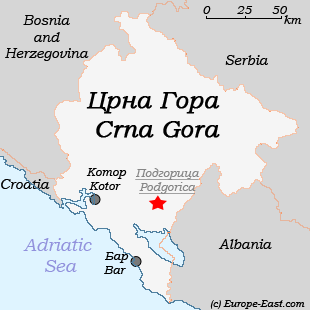Official name
The official name is Republika Crna Gora or Republic of Montenegro in English. The short form is ???? ???? (in Cyrillic) and Crna Gora in Latin alphabet respectively. Both words are Slavic - "Crna" means "Black" and "Gora" in almost any Slavic language "mountain". It's an old term in Slavic, which doesn't mean "Black Mountains" but "full of mountains". Which it is. This name was coined in the 13th century - before, Montenegro was no province or country by itself.
Venetians later adopted the name, but not without translating it - hence the Italian term Montenegro (=Black Mountain) as the name to use in English, German and so on. In many languages, Montenegro is called "Black Mountains" in the appropriate language - Albanians for example refer to it as Mali i Zi, which is just another translation.
Area & Population

| ||
| Clickable Map of Montenegro |
13,812 km² - less then half as large as Belgium or around the same size as Connecticut.
According to an estimate in 2007, around 685,000*. This means that Montenegro is a rather sparsely populated area - especially when keeping in mind that most people live along the coast line or in the capital region. And - the trend is negative at the moment.
Montenegro's population is mixed: Montenegrins count for 43%, Serbians for 32%, Bosniaks 8%, Albanians 5%, others (Croats, Roma and more) 12%.
Religion
Religion corresponds to ethnic groups - the majority therefore (Montenegrins and Serbians) are Orthodox, many Albanians and Bosniaks are muslims. Roman-Catholic is rather a minor religion in Montenegro.
Time zone
GMT +01 hr (Central Europe Time), with daylight-saving time (+1 hour) in summer.
Due to the fact that Montenegro is home to many ethnic groups, the country has many official languages: Montenegrin, Serbian, Albanian, Bosnian and Croatian. According to a official census in 2003, 22% said that their native language would be Montenegrin, while 62% said it's Serbian.
A recently well discussed issue is the question, what separates Montenegrin from Serbian - is it a language on its own after all, or just another Serbian dialect? Without getting too much into linguistics, it's mainly about a proto-Slavic letter called "Yat". This boils down to how for example the Slavic word for "white" is spelled and pronounced: In Serbian, it's "beli", in Montenegrin, Bosnian Serbian, Slovenian etc. it's more like "bijeli".
However, it's not just a linguistic but also a political question: Montenegrin nationalists don't want to see "Serbian" as their own language but they prefer their own language. In general, it can be said that it's no problem at all to get around in Montenegro with Serbian, Croatian, Bosnian, Slovenian and the like - which means that Russian for example is helpful, though, although the latter won't allow complete dialogs without misunderstandings. In the southern part, →Albanian is widely used - note that Albanian has absolutely nothing to do with Slavic languages.
In Montenegro, as in Serbia, both alphabets are widely used - Cyrillic and Roman. For a short introduction into Serbian, see →Serbian (language).
©2024 Europe-East.com

 Albania
Albania Montenegro
Montenegro